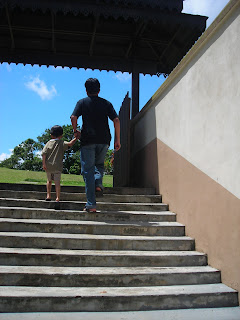
Since we were already on the East side of Johor, we realized that we were only like 40 minutes away from the popular Desaru Beach. So, my chauffeur (a.k.a. my dearest hubby) decided to continue his driving, with me at the co-pilot seat struggling with the map and trying to look for directions. Nevertheless, driving along the roads to Desaru was rather enjoyable.

We came across a stall selling Putu Bamboo (i.e. a traditional Malay delicacy, made from ground rice flour, with generous amount of Gula Melaka (palm sugar) mixed in the middle, steamed in bamboo casings and served with grated fresh coconut) by the roadside. So we made a quick stop and ordered some of this delectable Malay kuih.


It was a beautifully sunny afternoon when we reached Desaru. There were an array of hotels, motels and chalets along the road towards the beach but we went straight to the public beach area, a popular spot for the locals to have their weekend picnics with friends and family. It was our day-trip to Desaru so we wouldn’t need a room anyway. Not on this trip at least. We parked our car at the Desaru Holiday Chalet’s car park, and made our way to the beach.

From afar, we could hear the raging waves. It was in late November so it was still the monsoon season – that explained why the waves were rather strong at the time. But, there were hundreds of people having a great time swimming in the not-so-crystal-clear water despite the strong waves. It was kind of dangerous.


But for us, we brought along our beach mat and 2 small pillows and after settling ourselves at a good spot, we just sat back and enjoyed the scenery while my son had fun playing with the bubbles.



We then had our lunch at a restaurant near the public beach. It was a ‘so-so’ kind of restaurant that serves local food. The food was nothing to shout about but since we had not much of a choice, and since that was perhaps the nearest outlet for us to have our meal without having to drive out of the place, we allowed ourselves to succumb to the notion. I ordered for a plate of Mee Hailam (i.e. yellow noodle cooked in dark soya sauce with lots of vegetables, meat and seafood) while my hubby asked for a Mee Bandung (i.e. yellow noodle cooked in sweet sour sauce, with meat, eggs and seafood but without any veggies for him). Those piping-hot noodles were served to us within minutes. Great! We were already quite hungry at that time.


And what did my son have for his lunch? This picky-eater just enjoyed his 2 scoops of chocolate ice-cream and some french fries.


If there is one thing I must warn you if you intend to visit Desaru just for a day trip (without any room bookings at any hotels), it had to be the public toilet. If you really, really need to ‘do’ it, then you have no choice but to close your eyes and trash into this one pathetic-looking toilet at the public beach area. What is it with Malaysians and their Public Toilets? They just don’t jive together. Is it just me or is it because we, Malaysians often regard Public Toilets as ‘Dirty Areas’ that do not warrant any bit of cleanliness at all? Believe me, you would rather hold your ‘needs’ and go search for the nearest petrol kiosk, or a hotel or any proper restaurant nearby. You wouldn’t mind holding it because the stench from the toilet could put you off even if you are still miles away. Malaysia Boleh? Malaysia Boleh Memalukan Bangsa Asing Kalau Perkara Sebegini Tidak Diambil Perhatian. What a shame!















































